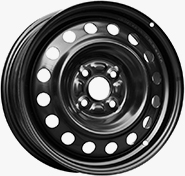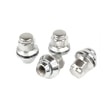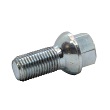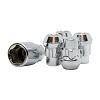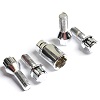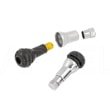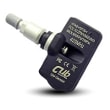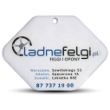AdBlue - how does it work and what function does it perform in the car?
In recent years, drivers have increasingly encountered the term AdBlue – both when purchasing a new car and in everyday use. This special fluid has become a key element in the design of modern diesel engines. Why? Because it helps vehicles meet stringent emissions standards, such as Euro 6, which are designed to protect the environment from harmful nitrogen oxides (NOx).
AdBlue is found not only in passenger cars but also in trucks, buses, and agricultural machinery. However, many drivers still wonder: what is AdBlue? What is it for and how does it work? Can a lack of this fluid immobilize a car?
In this article, you'll find answers to these questions. We'll explain:
- what is AdBlue and what does it consist of,
- how the SCR system that uses this fluid works ,
- how to properly refill AdBlue in your car,
- what are the costs of its use and the consequences of its non-use,
- and why regular maintenance of AdBlue fluid is a guarantee not only of ecology, but also of the smooth operation of the engine.
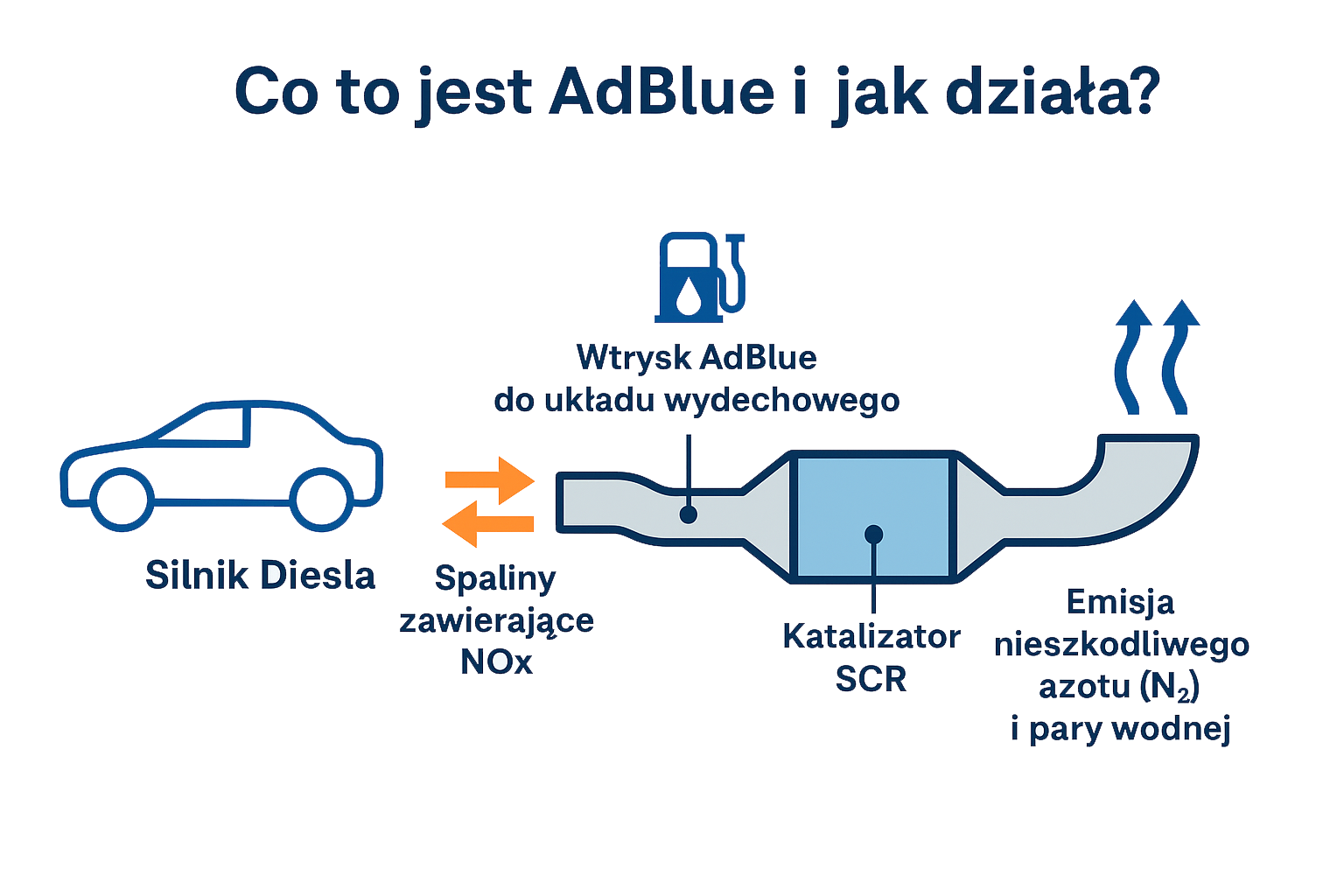
What is AdBlue? – Basics and Role in Modern Diesel Engines
Many drivers have heard of AdBlue , but the question still remains: what is AdBlue and what is it used for? This special fluid plays a key role in modern diesel cars, helping them meet stringent emissions standards. Using SCR (Selective Catalytic Reduction) technology, it's possible to significantly reduce nitrogen oxide (NOx) emissions—some of the most harmful exhaust gas components.
In this section, we explain exactly what AdBlue is, what it consists of, and what it means for the environment and diesel engine technology.
The chemical composition and production process of AdBlue fluid
AdBlue is the commercial name for a high-purity aqueous urea solution. It consists of:
- 32.5% urea (urea) of technical quality in accordance with the ISO 22241 standard
- and 67.5% demineralized water , free of minerals that could damage car systems.
It's worth emphasizing that AdBlue is not a fuel additive or a fuel in itself. It's a separate fluid stored in a dedicated tank in the vehicle and topped up independently of diesel fuel.
While AdBlue is neither toxic nor flammable, it should be handled with care – it can be corrosive to some metals and leave white residues if it evaporates. If spilled, simply rinse the area with water.
The role of AdBlue in reducing nitrogen oxide (NOx) emissions – selective catalytic reduction (SCR)
To understand what AdBlue does , you need to understand how SCR (Selective Catalytic Reduction) technology works. This system is designed to neutralize harmful nitrogen oxides produced during diesel combustion.
How does it work?
- AdBlue is injected into the exhaust system, just before the SCR catalytic converter.
- Under the influence of high temperature, the liquid decomposes into ammonia (NH₃) and carbon dioxide (CO₂).
- Ammonia reacts with nitrogen oxides (NOx) in the catalytic converter, transforming them into harmless nitrogen (N₂) and water vapor (H₂O) .
This is a simple, yet extremely effective method that has allowed car manufacturers to meet stringent exhaust emission standards – first Euro 5, and then Euro 6.
Thanks to SCR technology and AdBlue, diesel engines have become more environmentally friendly, reducing NOx emissions by up to 90%.
How do you know if your car is equipped with AdBlue?
More and more modern diesel cars require AdBlue, but not every driver is sure whether their vehicle is equipped with this system. How can you tell? There are a few simple steps you can take to identify the presence of SCR technology and the need to top up AdBlue.
Markings on the dashboard and in the vehicle documentation
Click on the lights to find out what they mean!
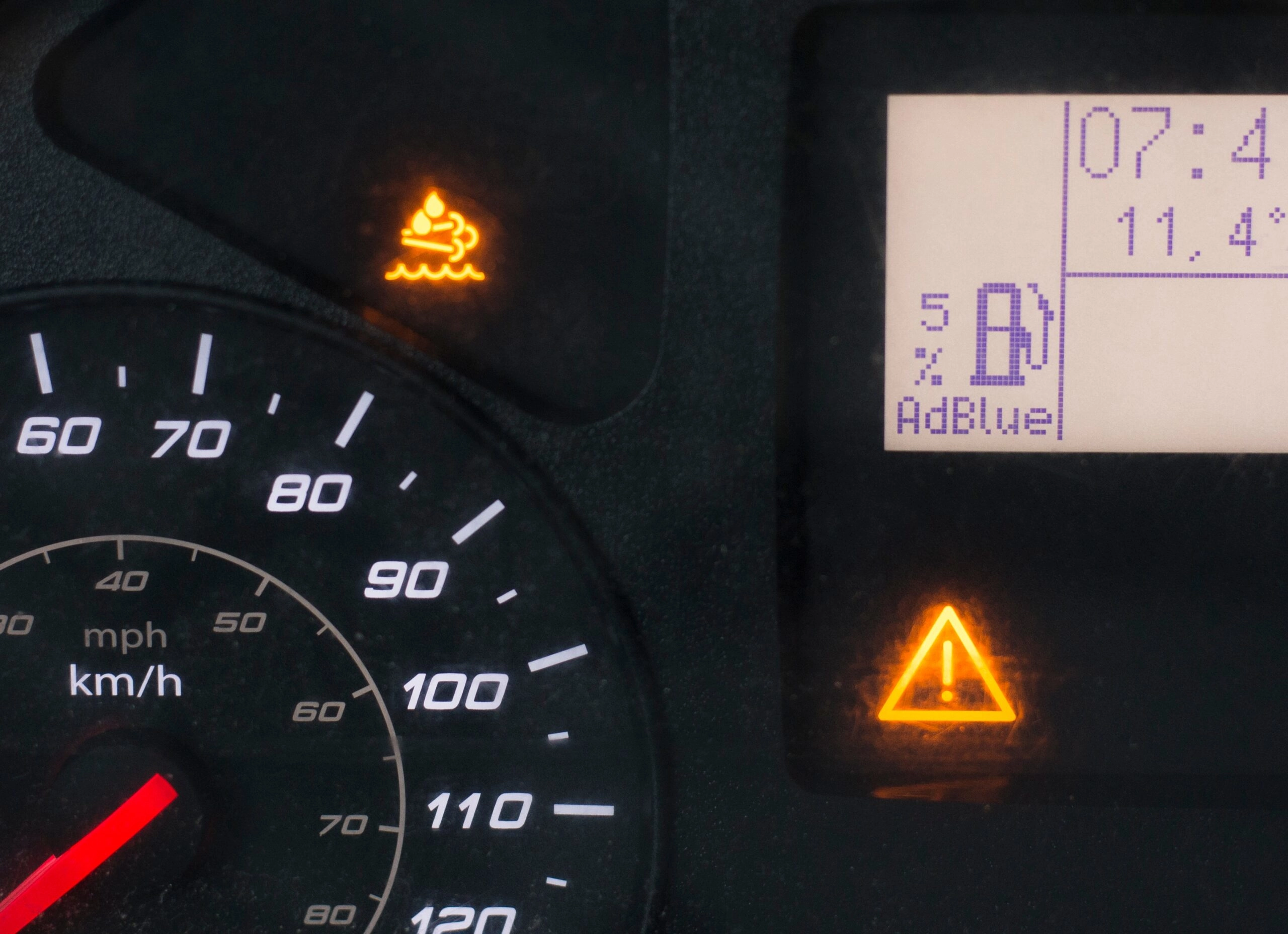
The first and easiest way to check if your car is using AdBlue is to check the dashboard indicators. Cars equipped with an SCR system often display a light like this:
- dispenser with a drop
- the inscription "AdBlue"
- or any other symbol relating to this fluid.
This light usually comes on when the AdBlue level in the tank is low and needs to be refilled.
An additional source of information is the vehicle's owner's manual . The manufacturer's documentation will provide detailed information about the vehicle's systems and instructions for using AdBlue.
It is also worth remembering that most new diesel cars manufactured from 2014–2015 are equipped with an SCR system and therefore require the use of AdBlue fluid.
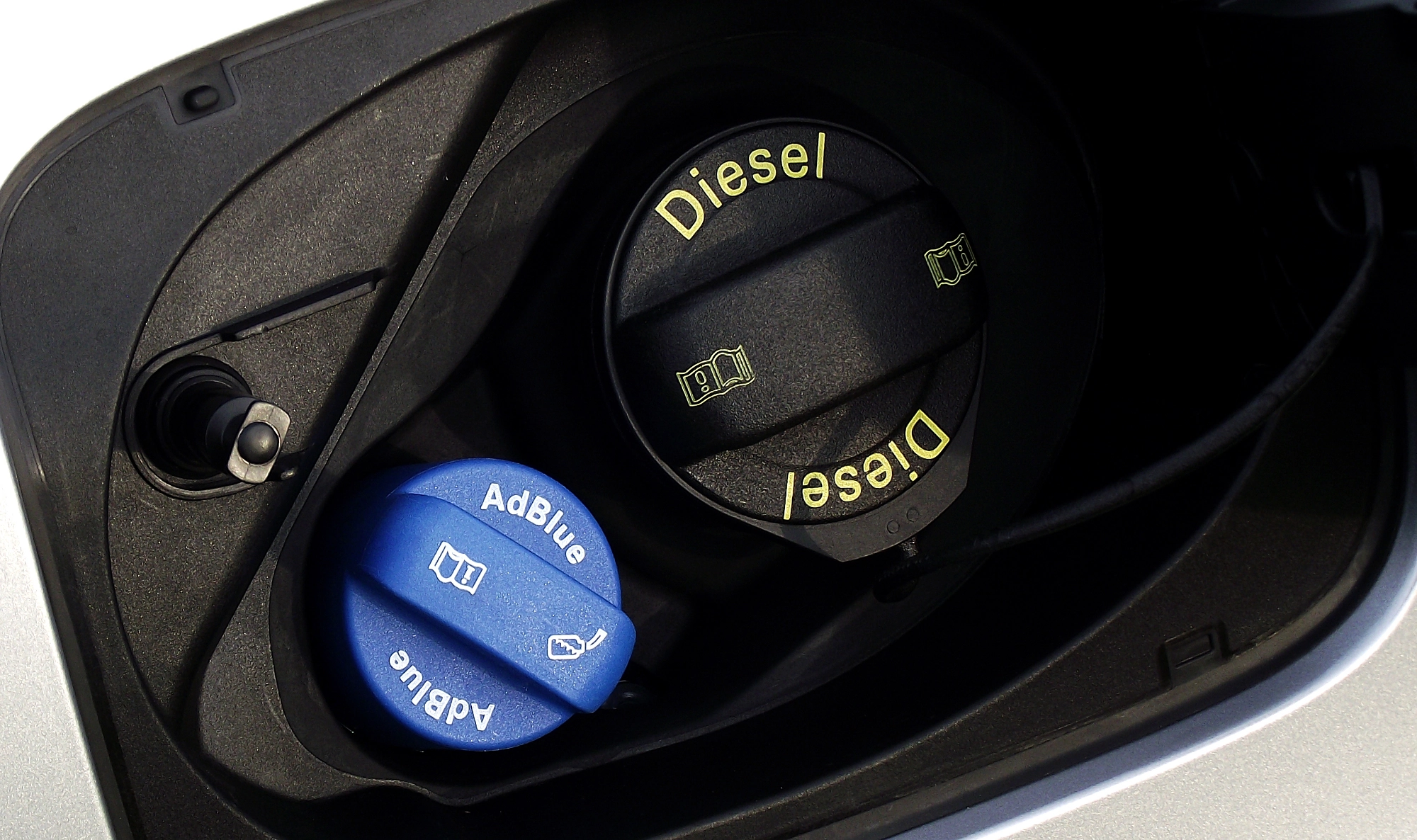
Additional fuel filler – a characteristic feature of vehicles with AdBlue
Another feature that helps you recognize a car with an SCR system is a separate AdBlue filler cap . This is most often located:
- right next to the traditional fuel filler (under the same flap)
- is marked with a blue cap or the words "AdBlue"
In some vehicles, the AdBlue filler cap may also be located in the trunk or under the hood, but it is always a separate tank intended solely for this fluid.
Important: AdBlue should not be confused with other fluids we pour into our cars , such as engine oil or coolant. Pouring it into the wrong place can lead to serious damage to the fuel system.
AdBlue in practice – what does refueling and refilling look like?
While refilling AdBlue may seem new to some drivers, it's actually a simple process that can be done easily at home or at a gas station. In this section, we'll show you where to find an AdBlue filler cap, the different forms of AdBlue available, and how to safely refill it.
AdBlue filler location and fluid packaging types
In most modern cars with an SCR system, the AdBlue filler is located:
- under the fuel filler flap (usually next to the diesel filler cap)
- in the trunk, under the floor or next to the spare wheel
- less often under the hood
A characteristic sign is a blue cap or the inscription "AdBlue", which allows you to easily distinguish it from other fillers.
There are various AdBlue packaging options available on the market to make refilling easier:
- bottles with applicators – convenient for drivers who want to refill the fluid at home
- canisters (5–10 liters) with tips for easy pouring
- AdBlue dispensers at petrol stations – they work similarly to traditional fuel dispensers and are becoming more and more popular.
How to refill AdBlue? – Step-by-step instructions
Topping up AdBlue is simple, but it is worth following a few rules to avoid problems:
- Turn off the engine and make sure the car is on level ground
- Locate the AdBlue filler cap (according to the vehicle manual)
- Open the liquid container (bottle, canister or use the dispenser at the gas station)
- Carefully pour AdBlue into the tank, avoiding spillage on the car's paintwork (the liquid may leave a white residue)
- Do not overfill the tank - add slowly until the recommended level is reached
- When finished, close the cap tightly and clean the filler area thoroughly.
In some vehicles, the system may need several minutes or an engine restart to register that the fluid level has been topped up.
Precautions and pollution prevention
AdBlue is a fluid that is extremely sensitive to contamination. Even a small amount of dust, fuel, or ordinary tap water can damage the expensive SCR system. Therefore:
- always use clean, factory-sealed packaging
- do not add fluid from unreliable sources
- Store AdBlue in a cool and dry place (optimally from -11°C to +30°C), away from direct sunlight.
Also, remember that AdBlue has a shelf life —usually around 12 months from the date of production. Using expired or contaminated fluid can lead to costly repairs.
Where to buy AdBlue and how much does it cost?
AdBlue is a fluid whose availability is increasing year by year. This is due to the fact that most new diesel cars require it, so manufacturers and retailers are responding to drivers' needs. So where can you buy AdBlue and how much does it cost?
AdBlue availability at petrol stations and automotive shops
AdBlue is now available in many places, making refilling the tank easy:
- Gas stations are the most popular place to buy AdBlue. At many stations, especially those serving trucks, you can fill up with bulk AdBlue from a dispenser. However, dispensers are increasingly appearing at passenger car stations as well.
- Automotive shops and supermarkets offer AdBlue in canisters of various sizes (from 5 to 20 liters), often with applicators to facilitate pouring.
- Authorised service centres – during an inspection or workshop visit, you can ask for AdBlue to be refilled.
Purchasing AdBlue from a pump is convenient and usually cheaper than buying canisters, but it requires driving to a station with the appropriate infrastructure. Canisters, on the other hand, allow you to refill the fluid anywhere, anytime.
Price range and factors affecting the cost of AdBlue
AdBlue prices vary depending on the place of purchase, packaging capacity and form of sale:
- From the dispenser at the petrol station: approximately from PLN 2 to PLN 4 per litre in the case of bulk refuelling (for passenger cars and trucks).
- In store-bought canisters: on average 20–40 PLN for 5 liters or 60–100 PLN for 10 liters. Small packages with applicators may be more expensive due to their convenience.
The cost of AdBlue fluid is influenced by several factors:
- Brand and reputation of the manufacturer.
- Fluid purity complies with ISO 22241 (the higher the quality, the higher the price).
- Seller's margin – prices at premium service stations and gas stations may be slightly higher than in supermarkets or wholesalers.
It is worth remembering that using cheaper or uncertified AdBlue can lead to damage to the SCR system, so it is always worth choosing products from reliable suppliers.
What is AdBlue efficiency? – Consumption and range
One of the most common questions from drivers using an SCR system is how much AdBlue their car uses and how often it needs to be refilled. AdBlue efficiency depends on many factors, so it's worth knowing what to expect to avoid unpleasant surprises down the road.
How much AdBlue does a car use? – Factors affecting consumption
AdBlue consumption – how much is enough?
| Vehicle type | AdBlue consumption (l/1000 km) |
|---|---|
 Passenger car Passenger car | 1–3 liters |
 Delivery truck Delivery truck | 3–5 liters |
 Truck Truck | 6–8 l |
AdBlue consumption is not constant and can vary depending on driving style and vehicle parameters. The amount of AdBlue burned is influenced by factors such as:
- Driving style – dynamic driving with frequent acceleration causes greater wear.
- Vehicle load – a fully loaded car burns more AdBlue.
- Road conditions – driving in the mountains or in urban areas increases the need for fluid.
- Ambient temperature – at low temperatures the SCR system operates slightly differently, which may affect wear.
- Engine type and power – larger engines usually require more AdBlue.
- AdBlue tank capacity – affects the frequency of fluid refilling.
For passenger cars, average consumption is typically 1–3 liters of AdBlue per 1,000 km . In trucks and delivery vehicles, it can be significantly higher.
Typical ranges on one AdBlue tank
AdBlue tanks in passenger cars typically have a capacity of 10 to 20 liters , allowing for a range of between 5,000 and 20,000 km without the need for a refill. Truck tanks are larger (50 liters or more), but their consumption is proportionally higher.
It's worth noting that car manufacturers designate AdBlue tank capacity to last for standard service intervals . This allows drivers to refill it during routine maintenance. However, with intensive vehicle use, it's worth checking the fluid level regularly to avoid running out mid-trip.
What to do if you run out of AdBlue? – Consequences and solutions
SCR systems in modern cars are designed to prevent drivers from suddenly becoming immobilized due to a lack of AdBlue. However, ignoring the warnings can lead to serious consequences. In this section, we explain what happens when AdBlue runs out and how to resolve the issue.
Dashboard warnings and what they mean
When the AdBlue level starts to approach the minimum, the car sends clear signals to the user:
- Text messages on the display, e.g. "Refill AdBlue - range: 2,400 km"
- Warning light (usually a dispenser symbol with a drop or the inscription "AdBlue")
- Audible signals that appear as the range decreases
The system is designed to give the driver ample time to refill the fluid. Depending on the vehicle model, warnings may appear up to several thousand kilometers before the AdBlue tank is completely depleted.
It's worth remembering that ignoring these messages may result in the car refusing to start after the engine is turned off until the AdBlue tank is refilled. This is a deliberate safety measure designed to enforce compliance with exhaust emissions standards.
Consequences of the lack of AdBlue - impact on engine operation and the ability to start
Running out of AdBlue in the tank can lead to serious performance issues. When the fluid level drops to zero and the driver ignores previous warnings, the SCR system automatically triggers safety measures:
- Once the engine is turned off , it may not be possible to restart it until the AdBlue tank is refilled.
- In some models, the vehicle goes into emergency mode – with limited power and maximum speed (e.g. to 20 km/h).
This solution is not a fault, but a deliberate mechanism designed to force the AdBlue to be refilled and prevent driving that does not meet the strict Euro 5 and Euro 6 emission standards.
Therefore, it is worth remembering that ignoring the system warnings may result in the car being immobilized at the least expected moment.
What to do in case of complete lack of fluid?
If the AdBlue level drops to zero and the vehicle does not allow the engine to be started, there are a few steps to take:
- Top up the appropriate amount of AdBlue – preferably at least 4–5 liters (depending on the manufacturer’s recommendations) so that the system registers the addition of the fluid.
- Wait a few minutes , then try starting the engine again. In most cars, the SCR system will automatically detect the new fluid level and allow starting.
- If the problem persists, it is recommended to visit a service center, as in some cases it may be necessary to clear errors from the on-board computer memory.
Warning : Never attempt to drive without AdBlue or use substitutes. This can lead to serious damage to the SCR system, resulting in costly repairs and voiding the warranty.
What are the advantages of using AdBlue?
AdBlue is not only a mandatory component of modern diesel cars, but also a solution that offers numerous benefits – both for the driver and the environment. It combines high engine efficiency with environmental protection and compliance with applicable regulations.
Reducing nitrogen oxide (NOx) emissions – ecological aspect
The main advantage of using AdBlue is its ability to significantly reduce emissions of harmful nitrogen oxides (NOx), which are produced during diesel combustion. These substances have a negative impact on:
- air quality , contributing to smog and acid rain
- human health , causing respiratory problems, especially in children and the elderly
- ecosystems , acidifying the soil and water, which harms plants and animals
Thanks to the use of SCR technology and AdBlue fluid , modern diesel engines are much more environmentally friendly and contribute to improving air quality in cities.
Compliance with exhaust emission standards (Euro 6 and newer)
The introduction of exhaust emission standards such as Euro 6 has forced car manufacturers to implement NOx reduction systems. AdBlue has become a key element in meeting these legal requirements.
- Without AdBlue, cars with SCR systems cannot meet the emission limits set by regulations.
- The lack of AdBlue or its removal may result in failing the technical inspection and imposing financial penalties in countries with strict environmental standards.
By using AdBlue, the driver can be sure that his vehicle operates in accordance with applicable law and does not generate excessive pollution.
Benefits for the user and the environment
Using AdBlue is not only a legal obligation, but also brings specific benefits to the vehicle owner:
- Maintaining full engine power and efficiency – the SCR system works optimally when the AdBlue tank is full
- Potential reduction in fuel consumption in units designed with SCR technology in mind – better combustion parameters translate into greater efficiency
- Longer life of exhaust system components thanks to reduced deposition of harmful substances
All this means that regularly topping up AdBlue fluid is not only good for the environment, but also for the driver's wallet and the technical condition of the car.
Can there be penalties for not using AdBlue?
SCR systems and AdBlue have become standard in modern diesel cars, primarily due to stringent emissions standards. However, some drivers attempt to bypass the need to refill the fluid, which can lead to serious consequences—both legal and technical.
Legal and technical consequences – impact on inspection and insurance
A vehicle with its SCR system disabled or modified cannot meet required emissions standards. In practice, this means:
- Inability to pass a technical inspection – diagnostic stations increasingly check emission levels, and exceeding the standards results in a negative test result.
- Risk of insurance problems – in the event of an accident, the insurer may refuse to pay compensation if it is proven that a faulty SCR system contributed to the incident or the vehicle did not comply with the type approval.
- Growing exhaust emission controls – in many countries, control authorities are increasingly monitoring vehicles for compliance with environmental standards, and the detection of a deactivated SCR may result in a fine or even the seizure of the registration certificate.
Potential problems when modifying the SCR system
Unauthorized devices, so-called AdBlue emulators , are appearing on the market. They trick car electronics by simulating the presence of fluid in the tank. While this may seem like a cost-saving measure, in practice, such solutions carry significant risks:
- They are illegal – the use of emulators violates environmental protection regulations and may result in high financial penalties.
- They damage the vehicle – interference with the SCR system can lead to failure of the exhaust system, turbocharger and even the engine itself.
- Warranty void – manufacturers clearly prohibit modifications to the emission reduction system, and detection of an emulator means cancellation of warranty coverage.
- High repair costs – restoring the SCR system to its factory condition can cost up to several thousand zlotys.
The conclusion is simple: regularly topping up AdBlue is not only an obligation, but also the best way to avoid costly and problematic situations.

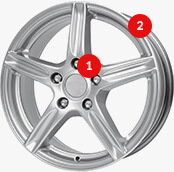

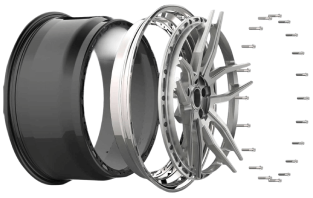
 Modern design
Modern design Perfect fit
Perfect fit High durability
High durability Free shipping within 24 hours
Free shipping within 24 hours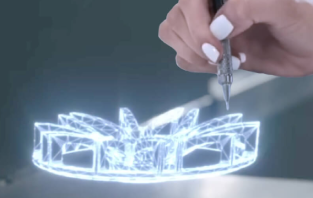
 Individual project
Individual project Dedicated caregiver
Dedicated caregiver